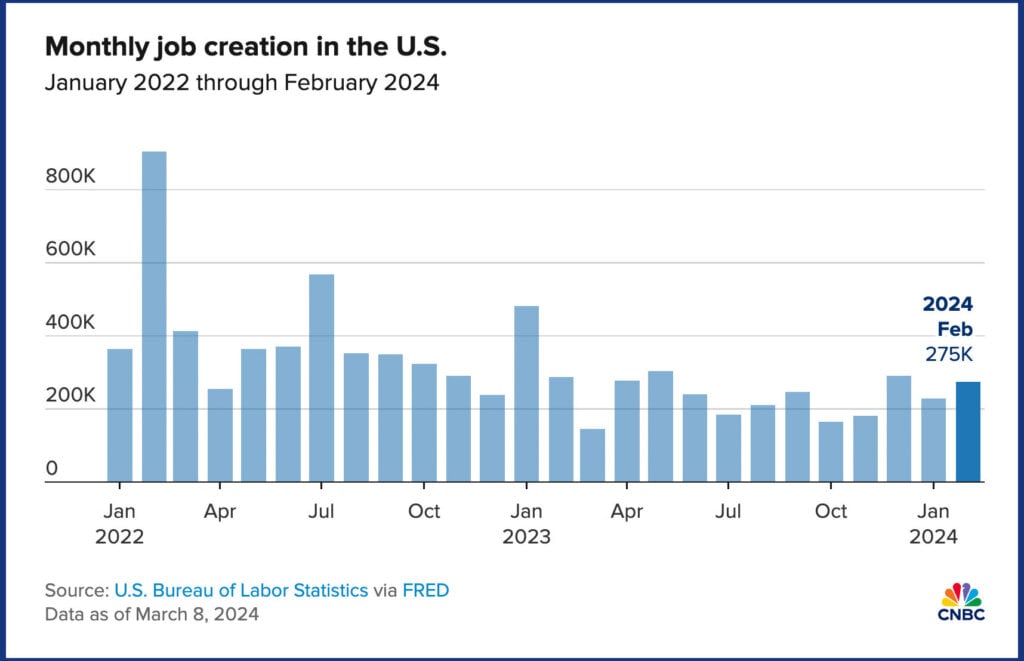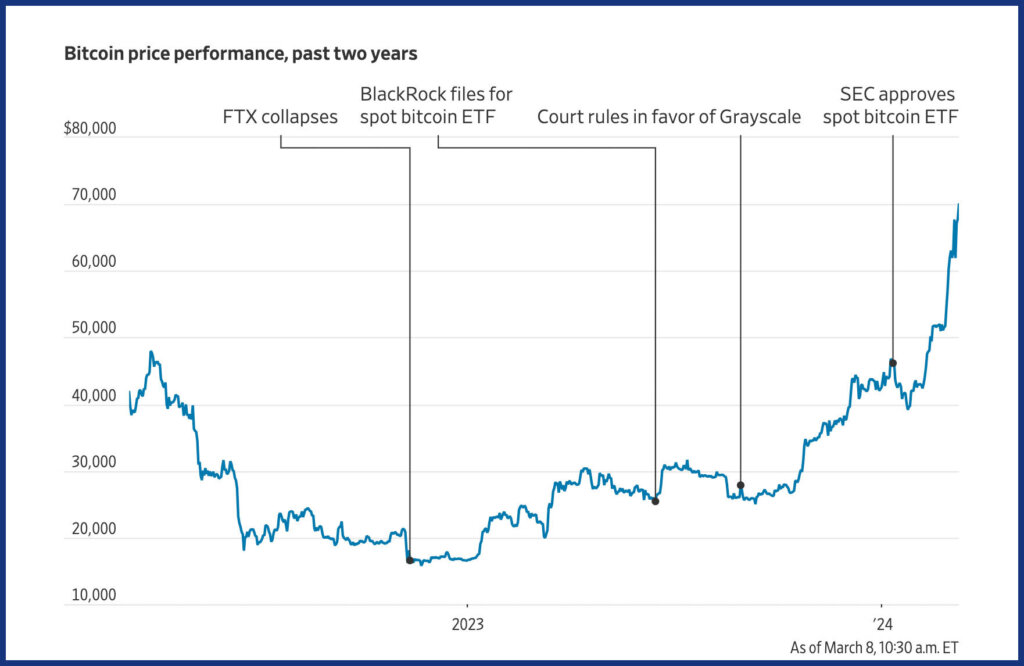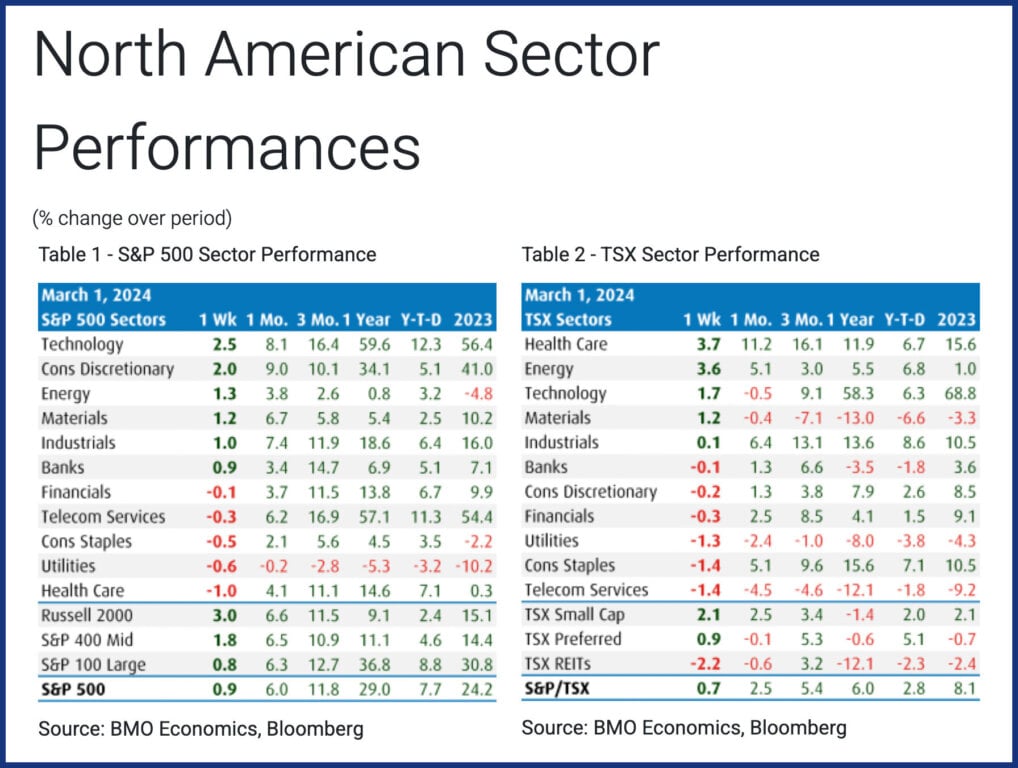Making sense of the markets this week: March 10, 2024
Allan Small, Senior Investment Advisor at the Allan Small Financial Group with iA Private Wealth, shares financial headlines and offers context for Canadian investors.
Earnings beat expectations—as expected
As we close out the first quarter’s earnings season, the biggest takeaway is that there were no surprises. Analysts’ expectations were largely met or exceeded. For example, Target reported earnings per share of $2.98 and revenues of $31.92 billion, beating expectations by 23.52% and 0.22%, respectively. (Figures in this section are in U.S. dollars.) It wasn’t just Target—between 70% and 80% of businesses reported first quarter earnings that beat expectations. This is what we usually see at this time of year.
However, dig a little deeper and the picture isn’t as typical as it may seem. Even though top-line and bottom-line growth beat expectations, when we compare these results to earnings from a couple of years ago, we notice that growth and profitability are slowing in some areas of the market. Many sectors—such as banking, retail and pharma, with the exception of big-cap tech and especially artificial intelligence—are not doing as well as they did a few years ago.
Coming out of 2022, the bar for growth was low. It was a different scenario in 2023, which ended on a high note. With each subsequent quarter going forward, the comparables will become even more challenging. The bar will rise for those companies that did well last year and continue to do well—particularly in the tech space. If tech cannot maintain the same pace of growth in subsequent quarters, we may see markets pull back at some point this year.
The latest quarterly earnings highlights
Here’s a sampling of recent earnings you should know about (all figures in U.S. dollars):
- Target Corp. (NYSE: TGT): Earnings per share of $2.98 (versus expected range of $1.90 to $2.60). Revenue of $31.92 billion (versus $31.83 billion expected).
- Costco (Nasdaq: COST): Earnings per share of $3.92 (versus $3.62 expected). Revenue of $58.44 billion (versus $59.16 billion expected).
- Broadcom (Nasdaq: AVGO): Earnings per share of $10.99 (versus $10.29 expected) in the first quarter of 2024. Revenue of $11.96 billion (versus $11.71 billion expected).

Earn up to 4% interest on your savings. Plus, use the pre-paid card for everyday purchases and free ATM withdrawls.

$0 commission on all transactions. No minimum deposit needed.

Save more every day with 4.00% interest on every dollar and flexible tools to grow your money.
MoneySense is an award-winning magazine, helping Canadians navigate money matters since 1999. Our editorial team of trained journalists works closely with leading personal finance experts in Canada. To help you find the best financial products, we compare the offerings from over 12 major institutions, including banks, credit unions and card issuers. Learn more about our advertising and trusted partners.
Investors shift to the macro for the big picture
Now that we’ve heard from most companies about their earnings, the focus on individual stocks and business performance is in the rearview—at least until the next quarterly reporting period. Investors have turned their attention to the economy and what the central banks are planning to do with interest rates. They are moving from the micro to the macro.
On Friday, March 8, the U.S. Bureau of Labor Statistics and Statistics Canada both updated the jobs picture.
The U.S. jobs report, in particular, always impacts the markets because of the size of the U.S. economy, while Canada’s employment numbers pack a much smaller punch. The U.S. added 275,000 jobs in February and the unemployment rate rose to 3.9%, following a remarkable 353,000 new jobs created in January. In Canada, 41,000 jobs were added in February and the unemployment rate rose to 5.8%.

There are a few other key dates to pay attention to this month. The U.S. Consumer Price Index rate for February will be announced March 12, followed by Canada’s CPI for February on March 19. Jerome Powell, chair of the U.S. Federal Reserve, will announce his decision on interest rates on March 20. The Bank of Canada held its benchmark rate steady at 5% (for the fifth time) on March 6.
Rising inflation was the catalyst for the central banks to start raising interest rates in 2022, but now that inflation rates seem to have stabilized, the expectation is that the Federal Reserve will pause on further increases. Even so, the statement it puts out will be important.
Right now, the U.S. economy is strong. There is no reason to cut interest rates. In my view, this is a win-win situation. If the economy were to falter quickly, the Federal Reserve would cut rates to help businesses. If the economy continues to grow at 3% to 4%—which is the current prediction for the first quarter of 2024 in the U.S.—the central bank won’t have to act. In both cases, the stock market will go up. We’ll see on March 28, when the U.S. Bureau of Economic Analysis will announce the U.S. 2023 Q4 GDP.
Bitcoin is skyrocketing thanks to the SEC
Wow. Just wow. For a brief moment on March 5, 2024, bitcoin recently hit an all-time high slightly above USD$69,200, beating its previous peak of USD$69,010 in November 2021. The cryptocurrency has been rising since October 2023, but prices really started to surge in January after the U.S. Securities and Exchange Commission (SEC) approved bitcoin exchange-traded funds (ETFs). American retail investors have been waiting a long time for a way to invest in cryptocurrency without having to own the digital tokens themselves. Now they can choose from 10 bitcoin ETFs, including funds from investment giants BlackRock and Fidelity. Collectively, the new bitcoin ETFs have already attracted billions of dollars. An ethereum ETF is likely around the corner. (Canadian investors already had access to bitcoin ETFs—Purpose Investment’s bitcoin ETF launched in February 2021, and at least three ethereum ETFs were launched by various Canadian firms a few months later.)

For me, this is an asset class that is still speculative. I’m not alone. Executives from Vanguard say they are not offering crypto products because they don’t see an “enduring” role for them in long-term portfolios. SEC chair Gary Gensler made a point of saying the approval of bitcoin ETFs was not an endorsement, and that he views crypto as a “speculative, volatile asset.”
Right now, there is no government body or country backing digital currencies—at least, not yet. Until this happens, I don’t know where they fit into the economy. My view: At this point, crypto represents too much risk for most investors. It’s certainly not a core holding for the investors I work with.
Gold also has been rising of late, and I met with David Garofalo of Gold Royalty Corp. about the rise of gold on March 6, 2024.
TSX significantly underperforming the S&P 500
The TSX Composite Index is up just 5% year over year compared to nearly 30% for the S&P 500. Why has the TSX fallen short? Primarily because of which economic sectors it focuses on. Specifically, there is a lack of high-growth technology stocks in Canada. The majority of the TSX is made up of banking, oil and gold stocks. For a while now, banking has been flat at best. Oil stocks have dropped in price. Even though gold is at an all-time high, gold stocks have not fared as well. Meanwhile, 40% of the companies on the S&P 500 are in the technology sector, which led to its strong performance. BMO senior economist Robert Kavcic points out that just “five [tech companies]—Nvidia, Microsoft, Amazon, Meta and Apple—have alone accounted for almost half of the net 1,200 point increase in the S&P 500 over the past year.” More than half the companies on the Nasdaq are also technology stocks. Even the Dow Jones Industrial Average has a growing number of technology stocks, including Apple, Salesforce and Amazon.

The TSX did very well during the China-driven metals super-cycle, when that country was buying up all the copper, aluminum and iron ore it could to build infrastructure. Those days are over. China’s economy is slowing, and that’s impacting Canadian companies and the TSX.
Canada’s economy is the secondary reason the TSX isn’t doing as well as U.S. indexes. Canadian GDP grew by 1% over the last year, while U.S. GDP grew by 3.2%. As a result, Canada is not as attractive to foreign investment as the U.S. We discussed the TSX’s underperformance on the Allan Small Financial Show.
My advice for Canadian investors: don’t worry about a weaker Canadian dollar, and invest in the U.S. Whatever you may lose on the dollar when you buy good-quality U.S. stocks, you’ll make it up and gain more when you sell.
Read more about investing:
- What to do if you overcontributed to your RRSP
- Using a HELOC as an investment strategy: not as taboo as you might think
- What Canadian investors can do in times of world crisis and war
The post Making sense of the markets this week: March 10, 2024 appeared first on MoneySense.


No comments